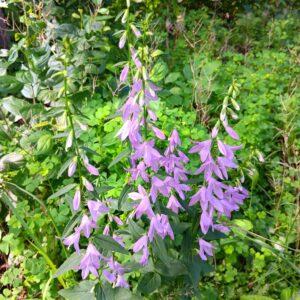Invasive plants and insects seem to be identified almost every day. In many instances, they are by-products of our global economy or human migration. For example: The emerald ash borer is native to northeastern Asia, including China, Japan, Korea, and Northern China. It was first detected in the United States in 2002 in the Detroit area. It was possibly introduced in the mid-1990s via infected ash wood used in shipping crates from one of those countries. Source: Wisconsin DNR.
That brings us to the purple creeping bellflower. The plant is at its purple peak right now, blooming on the edges of yards and along roadways. Beware however, this plant is native to central and southern Europe, west Asia, and the Caucasus. European settlers brought it to North America as a garden plant, where it has become naturalized. For many years, it was sold in nurseries. Our grandmothers cultivated it for bouquets! Unfortunately, the bellflower has been thriving to where it has worn out its welcome.
The problem is, creeping bellflower has a very strong and extensive root system so it spreads quickly. It will easily take over a garden and choke out other plants. It can most effectively be removed by digging or smothering. For those who prefer chemicals, that method is not foolproof. Learn more from Hennepin Master Gardeners about the plant and its removal.
Per Hennepin Master Gardeners: “Basically, creeping bellflower is hell bent on world domination.”
Read more at Star Tribune.
Was this post useful?
Average rating 5 / 5. Vote count: 2
No votes so far! Be the first to rate this post.












